Content
Published:
Next release:
Updated:
Fewer thefts and narcotic offences
In 2016, 336 500 offences were reported to the police. This was 4.3 per cent fewer than the year before, and a decline of as much as 9.6 per cent from 2014. If we factor in the population growth, this level of reported offences is by far the lowest in the 24 years of these statistics.
| 2016 | Change in per cent | ||||
|---|---|---|---|---|---|
| 2015 - 2016 | 2011 - 2016 | 2006 - 2016 | 2001 - 2016 | ||
| Offences reported | 336 413 | -4.3 | -11.5 | -16.0 | -19.4 |
| Offences reported per 1 000 population | 64.5 | -5.1 | -16.5 | -25.3 | -30.3 |
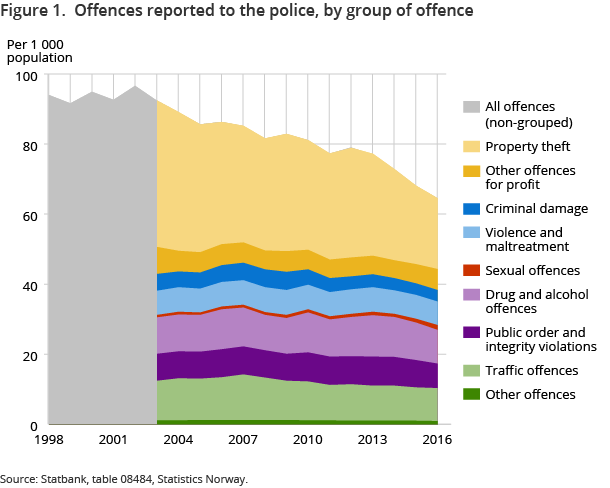
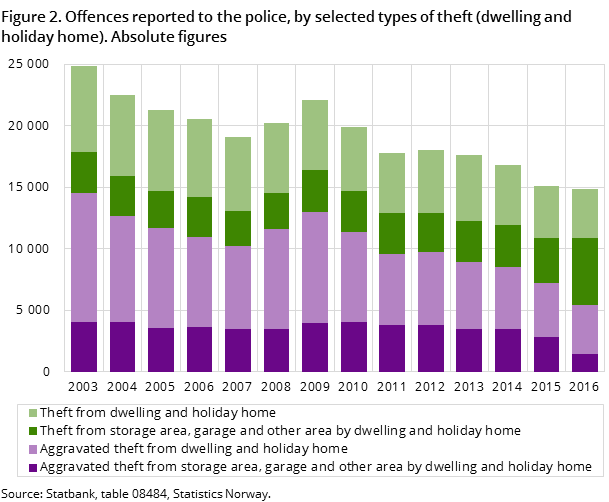
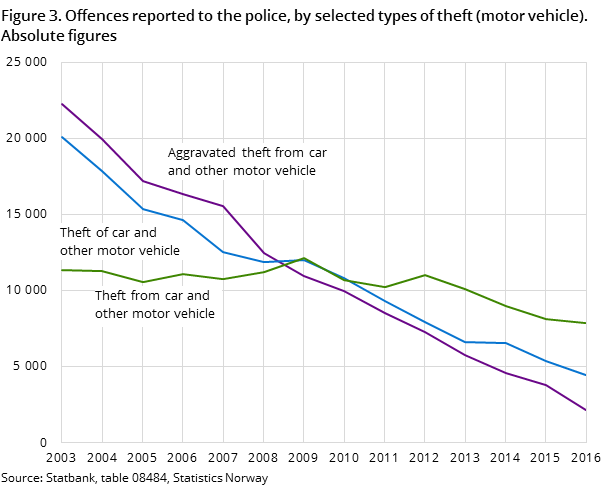
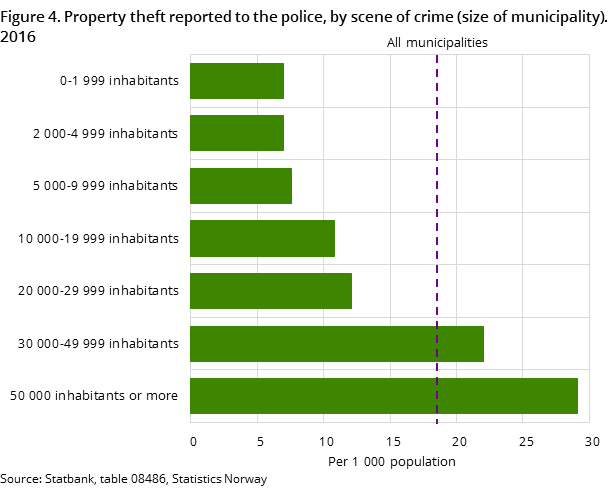
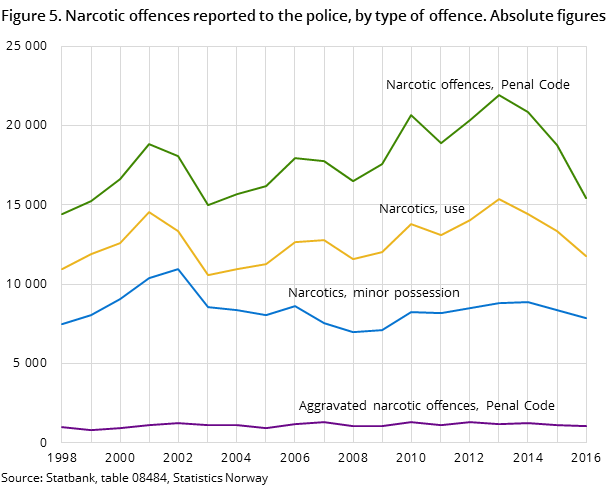
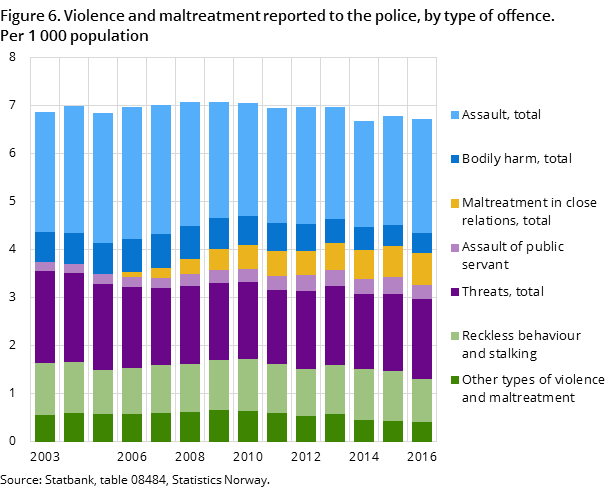
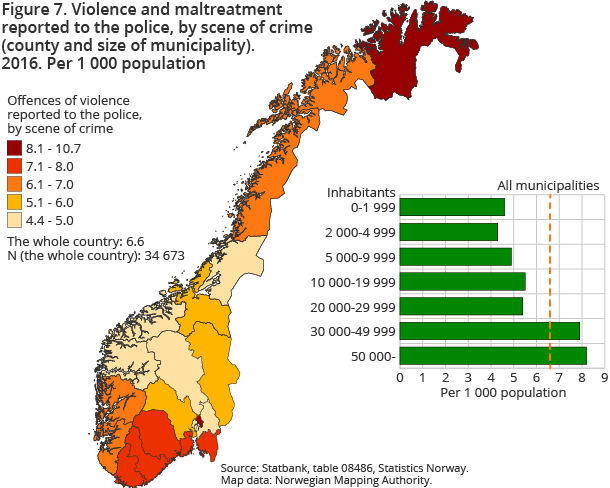
In 2016, 64.5 offences were reported to the police per 1 000 population. As shown in figure 2, far fewer property thefts are registered than in earlier years, and the 20.2 property thefts per 1 000 population in 2016 represents half the level of 2003. Furthermore, there has been a significant decrease in reported drug and alcohol offences during the last two years, which is also a contributing factor to the level of reported crime in 2016 being the lowest ever registered in these kinds of statistics.
Major decrease in reported property thefts
The police and prosecution authority registered just over 105 100 property thefts in 2016. Among these, 69 200 registered thefts made up two thirds, while the 17 200 incidents of aggravated theft made up a share of 16.5 per cent. There were also nearly 13 600 petty thefts registered.
In 2016, 7 900 thefts and 2 100 aggravated thefts from – as well as nearly 4 500 thefts of – cars and other motor vehicles were reported to the police. The number of these kinds of motor vehicle-related thefts has seen a decrease of 16 per cent from the year before. Furthermore, 14 800 thefts (incl. aggravated thefts) were registered from dwellings and holiday homes. As shown in figures 2 and 3, the declining trends observed for these types of thefts over time have thus continued, and the number of such thefts is now 39 200 and 10 000 fewer than in 2003 respectively.
The decrease in thefts of and from motor vehicles – together with thefts from dwellings and holiday homes – make up nearly 60 per cent of the total decrease of 85 100 property thefts since 2003.
Better statistics on theft from 2016
As of 2016, the new police codes for registering offences has made it possible for Statistics Norway to classify theft by more new types, which among other things enables better analyses of thefts from the person. In 2016, for example, nearly a third of almost 31 000 thefts from the person (incl. aggravated thefts) happened in a shop or other sales outlet, while nearly one in five occurred on public transport. Furthermore, nearly 17 per cent of these types of thefts happened in a street, park or at other recreational areas.
Since the new Norwegian penal code came into effect, there seems however to have been a partial redistribution from aggravated thefts to “ordinary” thefts. This is particularly evident for thefts from the person, which in 2016 saw a considerably smaller share of aggravated thefts than in most previous years. This may partly be a result of the new provision about aggravated theft in the penal code, which has not continued the former legal wording that emphasized whether or not the theft had happened “from the person at a public place”. For more information, see also text box and article about New crime statistics (in Norwegian only).
One out of four property thefts happened in Oslo
In 2016, more than 90 per cent of reported property thefts happened in Norway; while just over 8 100 were registered with a crime of scene abroad. In total, 97 000 property thefts were registered as happening in Norway, of which 26 000 – over one quarter – had Oslo as the scene of crime. Taking the population into account, Oslo is still the county with by far the most property thefts – 39.5 per 1 000 population. Vest-Agder (23.6) and Rogaland (20.2) were the counties with the second and third highest levels of reported property thefts, while the county of Sogn og Fjordane had the lowest level in 2016 – with 5.3 property thefts per 1 000 population.
More than 21 000 incidents of fraud
According to the new classification of offences, just over 31 000 offences were registered as part of the group of crime other offences for profit. Among these economic types of offences, nearly 21 400 – or close to seven out of ten – were frauds, while more than 7 per cent were receipts of stolen property. The police and the customs authority also registered nearly 2 000 violations of the Customs Act.
One in six offences of violence were maltreatments in close relations
In 2016, close to 35 000 incidents of violence and maltreatment were reported to the police. Of these, there were almost 20 000 offences of violence – which in principal include physical violence. The 12 300 registered assaults represented an increase of nearly 5 per cent from 2015, while the 2 200 reported incidents of the more serious violent offence bodily harm saw a slight increase from the year before. In 2016, 27 murders were registered.
In 2016, the almost 3 450 registered incidents of maltreatment in close relations saw the continuation of the trend of an annual increase for this type of violent offence. Compared to 2015, this is an increase of 3.5 per cent, which means that one in six offences of violence in 2016 were maltreatments in close relations. The increases in assault and maltreatment in close relations also contributed to an overall increase of 4 per cent for offences of violence in 2016 from the year before.
A total of 8 600 threats were also reported, of which 328 were considered aggravated threats. Furthermore, 4 650 incidents of reckless behaviour and stalking were reported, and a total of 810 robberies (incl. aggravated robberies).
Slightly lower level of violence in the last three years
Taking the population growth into account, the level of violence and maltreatment has been relatively stable for the better part of the 2000s. However, as shown in figure 6, the population growth since 2014 has been proportionately greater than the increase in violence and maltreatment registered by the police. In 2016, 6.7 offences per 1 000 population were registered, which means the level of reported violence and maltreatment over the last three years has been somewhat lower than in the period 2003-2013.
Highest level in Oslo and Finnmark
As highlighted in figure 7, Oslo and Finnmark counties had the highest level of violence and maltreatment in 2016 – as in all previous years. A total of 10.7 incidents of violence and maltreatment per 1 000 population were reported in Oslo, while the corresponding figure for Finnmark was 9.5. Sogn og Fjordane was the county with the lowest level – with 4.4 violence and maltreatment offences per 1 000 population.
Breakdowns of reported violence and maltreatment by municipality population size and centrality clearly show that the level of such offences generally increases with the number of inhabitants in a municipality and its degree of centrality. From the 4-tier classification of centrality, 5.0 offences of violence and maltreatment per 1 000 population were reported in the least central municipalities, while the corresponding figure for the most central municipalities was 7.0.
Large drop in reported drug and alcohol offences
In total, 53 300 drug and alcohol offences were reported in 2016. Among these, narcotic offences made up more than 70 per cent, while the 9 900 incidents of driving under the influence corresponds to almost one fifth. Additionally, 1 800 doping offences were registered during 2016, which constitutes an increase of 19.5 per cent from the year before.
Of the total 36 200 reported narcotic offences in 2016, almost 19 700 were violations of the Act relating to medicinal goods etc. and 16 500 were narcotic offences against the penal code. This is 9.5 and 17 per cent fewer than in 2015 respectively, and as illustrated in figure 5, there have been considerable annual changes in the number of reported narcotic offences. Furthermore, the big drop in narcotic offences made up over one third of the total decrease in offences reported to the police from 2015 to 2016.
More detailed statistics on public order and integrity violations
During 2016, over 36 600 public order and integrity violations were reported to the police. Using the new classification of offences, these are broken down into 15 200 violations of public authority, 13 300 public order violations and 8 100 violations of integrity.
As a part of violations of public authority, almost 10 400 incidents of obstructing and counteracting public authority were registered in 2016. Of these, two out of three offences were matters of harassing and obstructing a public servant, failing to comply with obligation of identification and violations of other types of orders issued by the police and public authority. In 2016, 2 400 violations of immigration legislation were also registered. With regard to public order violations, these include 6 900 violations of weapons, fire and explosives legislation, as well as 6 400 breaches of the peace.
In 2016, almost two thirds of integrity violations reported to the police were various types of document and ID offences. From 2016 and onwards, Statistics Norway’s classifications include unlawful handling and use of another’s identity or proof of identity as separate types of offences. In 2016, 2 100 and 470 of such ID offences were registered respectively.
More sexual offences reported to the police
Nearly 7 100 sexual offences were reported in 2016, which is 24 per cent more than the year before and an increase of as much as 48 per cent compared to 2014. This is mainly due to the 2016 increase in reported rapes, sexual acts and sexually abusive behaviour.
In total, 2 235 rapes were reported in 2016 – based on how rape is now defined in the penal code and in Statistics Norway’s crime statistics. One significant change in the new penal code – and thus in Statistics Norway’s classifications – is that what was formerly defined as sexual intercourse with children under 14 years of age is now classified as rape. In 2016, there were 674 reported rapes of children under the age of 14 (incl. aggravated rape). A total of 1 561 rapes were also reported with an unknown or unspecified age, which is comparable to the number of rapes according to the classification in the crime statistics until 2014. This includes 68 aggravated rapes.
In 2016, 1 300 sexual acts and 1 500 incidents of sexually abusive behaviour were also reported to the police. In total, there were 1.4 sexual offences per 1 000 population, and the level of sexual offences in 2016 is by far the highest registered with these type of statistics.
New statistics with new classification of offences 2003-2016Open and readClose
Statistics Norway now releases statistics by new Standard for types of offence. Types of offence 2015 is made as a consequence of the penal code of 2005, together with new police codes for registering offences, came into effect on 1 October 2015. The standard includes new groupings of both Type of offence and Group of offence, while Category of offences (crime and misdemeanour) is not continued. New classification of offences is made available for certain tables in StatBank with figures dating back to 2003. Group of offence 2015 and Type of offence 2015 are included in the existing tables. A detailed overview, including relation to the police codes for offences, is now available in Statistical Classifications and Code Lists.
New police districts from 1 January 2016Open and readClose
On 1 January 2016, Norwegian police were organised into new regional districts, where 27 police districts were reduced to 12. The internal process of organising the new districts will be executed gradually during the course of 2017 and 2018, but as of year 2016, Statistics Norway will only release statistics by the new police districts in StatBank.
The new police districts are mainly organised by merging the former districts. However, in the new organisation, the former Midtre Hålogaland PD is divided by the county border between new Nordland PD and Troms PD. For a detailed overview of the new police districts, including their relation to municipalities, see Statistical Classifications and Code Lists and About the statistics.
Contact
-
Reid Jone Stene
E-mail: reid.jone.stene@ssb.no
tel.: (+47) 99 02 22 01
-
Siri Fjærtoft Fossanger
E-mail: siri.fossanger@ssb.no
tel.: (+47) 99 72 49 27
